Sonata form - Study guides, Class notes & Summaries
Looking for the best study guides, study notes and summaries about Sonata form? On this page you'll find 309 study documents about Sonata form.
All 309 results
Sort by
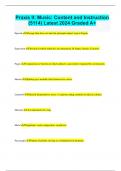 Popular
Popular
-
Praxis II: Music: Content and Instruction (5114) Latest 2024 Graded A+
- Exam (elaborations) • 86 pages • 2024
- Available in package deal
-
- $10.99
- 1x sold
- + learn more
Praxis II: Music: Content and Instruction (5114) Latest 2024 Graded A+ Episode Passage that does not state the principal subject (esp in Fugue) Exposition Section in which subject(s) are announced. In Fugue, Sonata, Concerto. Fugue Composition or Section in which subject is answered or repeated by several parts. Hocket Splitting up a melodic line between two voices Leitmotif Musical theme/motive assoc. w a person, thing, emotion or idea in a drama Monody Accompanied solo son...
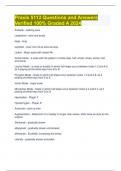 Popular
Popular
-
Praxis 5113 Questions and Answers Verified 100% Graded A 2024
- Exam (elaborations) • 23 pages • 2024 Popular
-
Available in package deal
-
- $12.99
- 1x sold
- + learn more
Andante - walking pace Largissimo - slow and broad largo - long larghetto - slow, but not as slow as largo Lydian - Major scale with raised 4th Dorian Mode - a scale with the pattern of whole step, half, whole, whole, whole, half, and whole Locrian Mode - a scale or tonality in which half steps occur between notes 1-2 and 4-5, as if playing all the white keys from B to B Phrygian Mode - Scale in which half steps occur between notes 1-2 and 5-6, as if playing all white keys f...
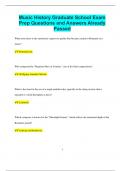
-
Music History Graduate School Exam Prep Questions and Answers Already Passed
- Exam (elaborations) • 83 pages • 2024
-
Available in package deal
-
- $11.99
- + learn more
Music History Graduate School Exam Prep Questions and Answers Already Passed What term refers to the emotional, expressive quality that became central in Romantic-era music? Romanticism. Who composed the "Requiem Mass in D minor," one of his final compositions? Wolfgang Amadeus Mozart. What is the term for the use of a single melodic idea, typically in the string section, that is repeated or varied throughout a piece? Leitmotif. Which composer is known for the ...

-
Praxis 5113 Latest 2024 with Certified Solutions
- Exam (elaborations) • 53 pages • 2024
- Available in package deal
-
- $10.99
- + learn more
Praxis 5113 Latest 2024 with Certified Solutions Andante walking pace Largissimo slow and broad largo long larghetto slow, but not as slow as largo Lydian Major scale with raised 4th Dorian Mode a scale with the pattern of whole step, half, whole, whole, whole, half, and whole Locrian Mode a scale or tonality in which half steps occur between notes 1-2 and 4-5, as if playing all the white keys from B to B Phrygian Mode Scale in which half steps occur between notes 1-...
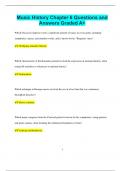
-
Music History Chapter 6 Questions and Answers Graded A+
- Exam (elaborations) • 12 pages • 2024
-
Available in package deal
-
- $9.99
- + learn more
Music History Chapter 6 Questions and Answers Graded A+ Which Classical composer wrote a significant amount of music in every genre, including symphonies, operas, and chamber works, and is known for his "Requiem" mass? Wolfgang Amadeus Mozart. Which characteristic of the Romantic period involved the expression of national identity, often using folk melodies or references to national history? Nationalism. Which technique in Baroque music involved the use of a bass line tha...
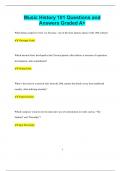
-
Music History 101 Questions and Answers Graded A+
- Exam (elaborations) • 21 pages • 2024
-
Available in package deal
-
- $9.99
- + learn more
Music History 101 Questions and Answers Graded A+ What Italian composer wrote "La Traviata," one of the most famous operas of the 19th century? Giuseppe Verdi. Which musical form, developed in the Classical period, often follows a structure of exposition, development, and recapitulation? Sonata form. What is the term for a musical style from the 20th century that breaks away from traditional tonality, often utilizing atonality? Expressionism. Which composer is known ...
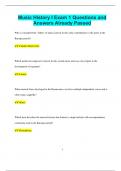
-
Music History I Exam 1 Questions and Answers Already Passed
- Exam (elaborations) • 37 pages • 2024
-
Available in package deal
-
- $10.99
- + learn more
Music History I Exam 1 Questions and Answers Already Passed Who is considered the "father" of opera, known for his early contributions to the genre in the Baroque period? Claudio Monteverdi. Which medieval composer is known for his sacred music and was a key figure in the development of organum? Léonin. What musical form, developed in the Renaissance, involves multiple independent voices and is often sung a cappella? Motet. Which term describes the musical texture ...
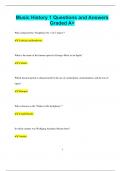
-
Music History 1 Questions and Answers Graded A+
- Exam (elaborations) • 20 pages • 2024
-
Available in package deal
-
- $9.99
- + learn more
Music History 1 Questions and Answers Graded A+ Who composed the "Symphony No. 5 in C minor"? Ludwig van Beethoven. What is the name of the famous opera by Georges Bizet set in Spain? Carmen. Which musical period is characterized by the use of counterpoint, ornamentation, and the rise of opera? Baroque. Who is known as the "Father of the Symphony"? Joseph Haydn. In which country was Wolfgang Amadeus Mozart born? Austria. 2 What is the title of the f...
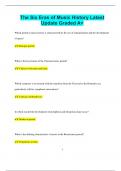
-
The Six Eras of Music History Latest Update Graded A+
- Exam (elaborations) • 12 pages • 2024
-
- $9.99
- + learn more
The Six Eras of Music History Latest Update Graded A+ Which period in music history is characterized by the use of ornamentation and the development of opera? Baroque period. What is the key feature of the Classical music period? Clarity of structure and form. Which composer is associated with the transition from the Classical to the Romantic era, particularly with his symphonic innovations? Ludwig van Beethoven. In which era did the development of polyphony and Gregorian ...
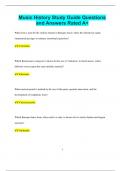
-
Music History Study Guide Questions and Answers Rated A+
- Exam (elaborations) • 12 pages • 2024
-
Available in package deal
-
- $9.99
- + learn more
Music History Study Guide Questions and Answers Rated A+ What term is used for the stylistic feature in Baroque music where the melody has rapid, ornamented passages to enhance emotional expression? Coloratura. Which Renaissance composer is known for his use of "imitation" in choral music, where different voices repeat the same melodic material? Palestrina. What musical period is marked by the rise of the piano, operatic innovation, and the development of symphonic form?...

$6.50 for your textbook summary multiplied by 100 fellow students... Do the math: that's a lot of money! Don't be a thief of your own wallet and start uploading yours now. Discover all about earning on Stuvia


